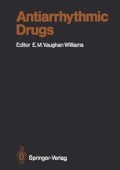Abstract
Over 100 years ago calcium was identified as a necessary element for cardiac muscular contraction (Ringer 1883). It was only about 20 years ago (Kaufman and Fleckenstein 1965) that calcium antagonists that inhibited the excitation contraction coupling process were identified. There are many different mechanisms by which calcium interacts within cellular processes and some drugs specifically act by blocking calcium channels and those are more appropriately termed the “calcium channel blockers” (Katz and Reuter 1979). A complete classification system for calcium active agents is still evolving based on their pharmacologic and electrophysiologic actions.
Access this chapter
Tax calculation will be finalised at checkout
Purchases are for personal use only
Preview
Unable to display preview. Download preview PDF.
References
El-Sherif, Lazarra R (1979) Reentrant ventricular arrhythmias in the late myocardial infarction period. 7. Effect of verapamil and D-600 and the role of the “slow channel”. Circulation 60: 605–615
Fondacaro ID, Han J, Yoon MS (1978) Effects of verapamil on ventricular rhythm during acute coronary occlusion. Am Heart J 96: 81–86
Gruen G, Fleckenstein A (1972) Die electromechanische Entkoppelung der glatten Gefassmuskulatur als Grundprinzip der Coronardilation durch 4– (2–Nitrophe- nyl) –2,6–dimethyl–l,4–dihydropyridin–3,5-dicarbonsaure-dimethylester (Bay a 1040, Nifedipin ). Arzneimittelforsch. 22: 334
Gulamhussein S, Ko P, Carruthers S, Klein GJ (1981) Acceleration of the ventricular responses during atrial fibrillation in the Wolff-Parkinson-White syndrome after verapamil. Circulation 65: 348–354
Hagemeijer F (1978) Verapamil in the management of supraventricular tachyarrhythmias occurring after a recent myocardial infarction. Circulation 57: 751–755
Katz AM, Reuter H (1979) Cellular calcium and cardiac cell death. Am J Cardiol 44: 188–190
Kaufmann R, Fleckenstein A (1965) Ca2+-competitive electromechanische Entkoppelung durch Ni2+- und Co2+-Ionen am Warmblutermyokard. Pflugers Arch Ges Physiol 282: 290
Kostis JB, McCrone K, Moreya AE Gotzoyannis S, Aglitz NM, Natarajan N, Kuo PT (1981) Premature ventricular complexes in the absence of identifiable heart disease. Circulation 63: 1351–1356
Lie KI, Duren DR, Manger Cats D, David GK, Durrer D (1983) Long-term efficacy of verapamil in the treatment of paroxysmal supraventricular tachycardias. Am Heart J 105: 668
Morganroth J (1984) Premature ventricular complexes: diagnosis and indication for therapy. JAMA 252: 673–676
Morganroth J (1985) Ambulatory Holter electrocardiography: choice of technologies and clinical uses. Ann Intern Med 102: 73–81
Morganroth J, Borland M, Chao G (1987) Application of a frequency definition of ventricular proarrhythmia. Am J Cardiol 59: 97–99
Morganroth J, Horowitz LN (1984) Flecainide: its proarrhythmic effect and expected changes on the surface electrocardiogram. Am J Cardiol 53: 89B–94B
Morganroth J, Michelson EL, Horowitz LN, Josephson ME, Pearlman AS, Dunk- man B (1978) Limitations of routine long-term electrocardiographic monitoring to assess ventricular ectopic frequency. Circulation 58: 408–414
Morganroth J, Chen CC, Sturm S, Dreifus LS (1982) Oral verapamil in the treatment of atrial fibrillation/flutter. Am J Cardiol 49: 981
Morganroth J, Anderson JL, Gentzkow GD (1986) Classification by type of ventricular arrhythmia predicts frequency of adverse cardiac events from flecainide. J Am Coll Cardiol 28: 607–615
Muller J, Morrison J, Stone P, Rude R, Rosner B, Roberts R, Pearle D, Turi Z, Schneider J, Serfas D, Hennekens C, Braunwald E (1983) Nifedipine therapy for threatened and acute myocardial infarction: a randomized double blind comparison. Circulation 68: 111–120
Ringer S (1883) A further contribution regarding the influence of the different constituents of the blood on the contraction of the heart. J Physiol (London) 4: 29–42
Rowland E, Evans T, Krickler D (1979) Effect of nifedipine on atrioventricular conduction as compared with verapamil: intracardiac electrophysiology study. Br Heart J 42: 124–127
Schamroth L (1971) Immediate effects of intravenous verapamil on atrial fibrillation. Cardiovasc Res 5: 419–424
Singh BN, Ellrodt G, Peters CT (1978) Verapamil: a review of its pharmacological properties and therapeutic use. Drugs 15: 169–197
Sung RJ, Elser B, McAllister RG (1980) Intravenous verapamil for termination of reentrant supraventricular tachycardias. Ann Intern Med 93: 682–689
Watanabe AM, Besch HR (1974) Subcellular myocardial effects of verapamil and D-600:comparison with propranolol. J Pharmacol Exp Ther 191: 241–251
Waxman HL, Myerburg RJ, Appel R, Sung RJ (1981) Verapamil for control of ventricular rate in paroxysmal supraventricular tachycardia and atrial fibrillation or flutter. Ann Intern Med 94: 1–6
Wellens HJJ, Bar FW, Lie KI, Duren DR, Dohmen HJ (1977) Effects of procainamide, propranolol and verapamil on mechanism of tachycardia in patients with chronic recurrent ventricular tachycardia. Am J Cardiol 40: 579–585
Wit AL, Rosen MR, Hoffman BF (1974) Relationship of normal and abnormal electrical activity of cardiac fibers to the genesis of arrhythmias. II. Reentry section II. Am Heart J 88: 798–807
Wu D, Kou H, Yeh S, Lin F, Hung J (1983) Effects of oral verapamil in patients with atrioventricular reentrant tachycardia incorporating an accessory pathway. Circulation 67: 426–433
Yeh S, Kou H, Lin F, Hung J, Wu D (1983) Effects of oral diltiazem in paroxysmal supraventricular tachycardia. Am J Cardiol 52: 271–278
Zipes DP, Fischer JC (1974) Effects of agents which inhibit the slow channel on sinus node automaticity and atrioventricular conduction in the dog. Circ Res 34: 184–192
Editor information
Editors and Affiliations
Rights and permissions
Copyright information
© 1989 Springer-Verlag Berlin Heidelberg
About this chapter
Cite this chapter
Morganroth, J., Horowitz, L.N. (1989). Class IV Antiarrhythmic Agents: Utility in Supraventricular Arrhythmias and Their Proarrhythmic Potential. In: Vaughan Williams, E.M. (eds) Antiarrhythmic Drugs. Handbook of Experimental Pharmacology, vol 89. Springer, Berlin, Heidelberg. https://doi.org/10.1007/978-3-642-73666-7_19
Download citation
DOI: https://doi.org/10.1007/978-3-642-73666-7_19
Publisher Name: Springer, Berlin, Heidelberg
Print ISBN: 978-3-642-73668-1
Online ISBN: 978-3-642-73666-7
eBook Packages: Springer Book Archive

